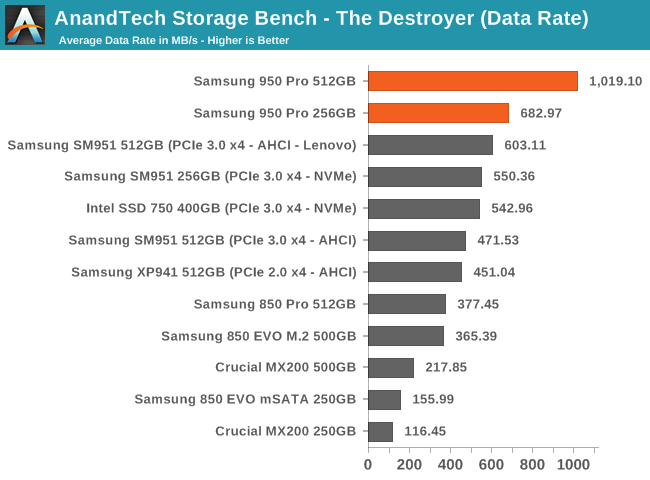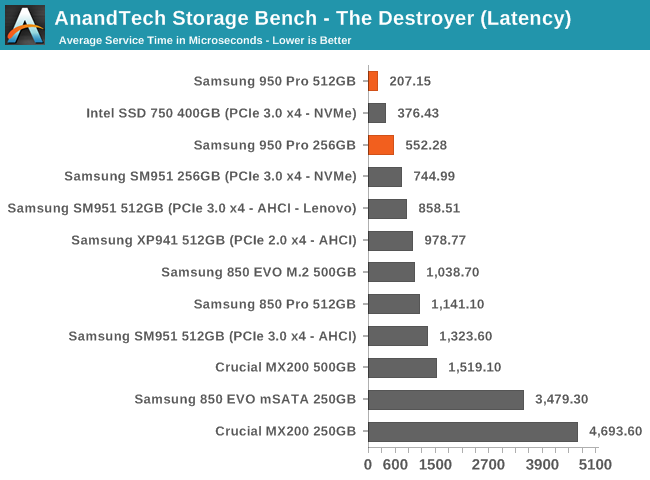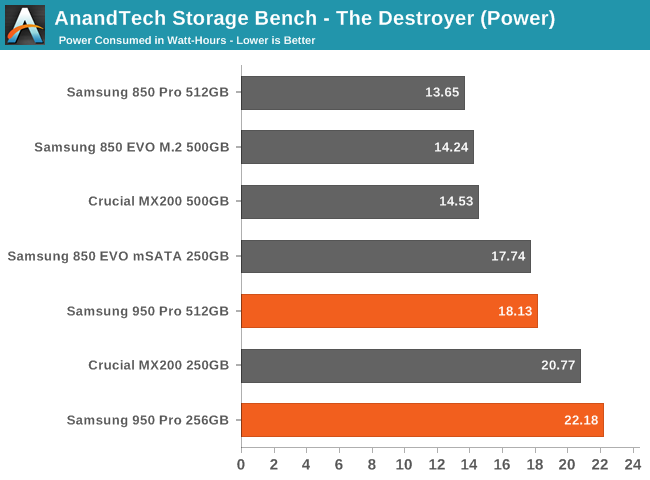The Samsung 950 Pro PCIe SSD Review (256GB and 512GB)
by Billy Tallis on October 22, 2015 10:55 AM ESTAnandTech Storage Bench - The Destroyer
The Destroyer is an extremely long test replicating the access patterns of heavy desktop usage. A detailed breakdown can be found in this review. Like real-world usage and unlike our Iometer tests, the drives do get the occasional break that allows for some background garbage collection and flushing caches, but those idle times are limited to 25ms so that it doesn't take all week to run the test.
We quantify performance on this test by reporting the drive's average data throughput, a few data points about its latency, and the total energy used by the drive over the course of the test.

Both 950 Pros deliver great performance on the destroyer, but the 512GB is outstanding. Clearly the more bursty nature of this test allows the drive to avoid any thermal throttling and deliver the high peak speeds that the PCIe interface is supposed to enable.

The NVMe drives deliver the lowest average service times, but the other PCIe drives are close behind. If there were any moments of thermal throttling like we saw with the performance consistency test, they would greatly inflate the average service time.

The very small number of performance outliers on this test is a good indicator that these drives don't sieze up under the pressure of an interactive workload.

When looking at the more strict latency threshold of 10ms, the 256GB 950 Pro is not significantly better than the good SATA drives, but the 512GB has extremely good control over latency.

Energy usage is not competitive with the high-performance SATA drives. As demanding as it is, The Destroyer still has opportunities for drives to scale back power consumption but the 950 Pro can't do that on our testbed.










142 Comments
View All Comments
herbc - Friday, October 23, 2015 - link
How fast do you really need to be happy with using a computer is my question , my computer is faster now than i actually need it to be and all it has is a current SSD .Woff - Friday, October 23, 2015 - link
I have a system with Asus X99 DeLuxe motherboard and a I7-5960X cpu. I use a Samsung 850 EVO 500GB SSD connected to one of the SATA ports, but I want to upgrade this device to a M.2 Samsung 950 Pro. The motherboard offers two ways to connect a M.2 but I don't know witch is the best alternative. The X99 has a on-board M.2 (socket3) but is also delivered with a expansion card, a 'HYPER M.2 x4' card. Anyone who can help me with the best (fastest) solution to my problem?Redstorm - Friday, October 23, 2015 - link
You should be OK to use the Onboard M.2 slot as the manual says "32Gb transfer for the onboard M.2" page 'x' so 4 x PCIe 3.0cjelliott - Tuesday, November 17, 2015 - link
How did you get on with this 950 Pro SSD on the X99 Deluxe? Can you boot from it? I am tempted to buy this SSD but have seen a lot of forums where people are having trouble. I want to install and boot Win 10 Pro from it.l_d_allan - Saturday, October 24, 2015 - link
Hmmmm ... the Samsung Galaxy review was at the top for 5 days, then one day for an ASUS mother board, and only one day for the Surface 4, and now several days for the Samsung PCie SSD.Seems unbalanced. Or just "the luck of the draw"?
Kristian Vättö - Sunday, October 25, 2015 - link
Usually content is only released on weekdays, so reviews that go up later in the week (e.g. on Thursday) may get several days of page time. Oftentimes the content release is dictated by an embargo lift, so the time of publishing isn't on AnandTech's hands.I can assure you that this is just a coincidence - there's no rule or contract that a certain company must get X number of days at the top. Frankly, it wasn't even something we thought about during my time at AnandTech as content always went up when it was ready and free for publishing.
Craig234 - Saturday, October 24, 2015 - link
"The Intel SSD 750 clearly needs to come down in price to be completely sidelined by the 950 Pro. "I think you mean to AVOID being completely...
TheBeagle - Saturday, October 24, 2015 - link
I case anybody is interested, Amazon.com has this lovely items for sale (pre-order) right now. The Amazon web site says the product will be released for sale on Thursday, October 29th. Hurry up before they're all gone - LOL! BeagleFXi - Saturday, October 24, 2015 - link
I know it's not a lot of space but some degree of power loss protection would have been proper for a "pro" device in this price category.Kristian Vättö - Sunday, October 25, 2015 - link
The 950 PRO, just like all Samsung client SSDs, do journaling to protect the FTL against sudden power losses. Protection for cached user data is not really needed since modern file systems have been designed to withstand minor data losses (HDDs also use DRAM to cache writes, so SSDs are no different in that sense).